
Seven Facts Concerning the Battle of Kursk
/ Главная / Russkiy Mir Foundation / Publications / Seven Facts Concerning the Battle of KurskSeven Facts Concerning the Battle of Kursk
On the 23rd of August Russia traditionally celebrates the Day of Military Glory, which commemorates the victory of the Soviet armed forces over the Wehrmacht at the Kursk Bulge. In the lead up to this crucial battle, the Red Army had spent almost two months in a strained condition fighting a series of bloody battles whose outcome was by no means predetermined. The Battle of Kursk was one of the largest military confrontations in world history. Here we consider the momentous occasion with some interesting details about the battle.
Fact 1
A huge salient was formed in the Soviet-German front as a result of a series of fierce battles that took place in the months of February and March in 1943 around the city of Kharkov. The salient, known to history as the “Kursk Bulge”, was 150 km deep and 200 km wide.
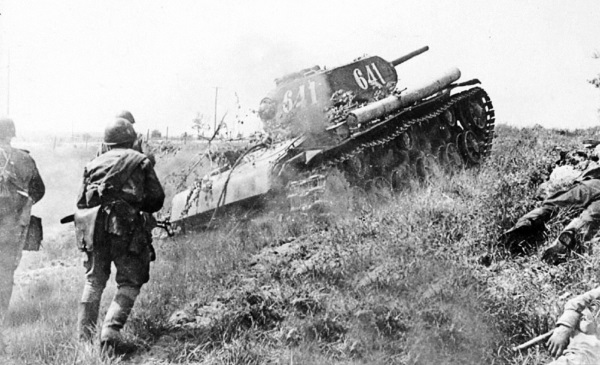
Fighting for the Kursk Bulge
Fact 2
The Battle of Kursk was one of the key confrontations of the Second World War, in terms of both its terrifying scale and its ultimate significance. The battle, involving thousands of tanks in a confrontation which raged for over six weeks in the peak of the summer heat, took place on the wide fields between the cities of Oryol and Belgorod in August and July 1943. The Soviet Victory marked the end in the turning-point phase of the war that had begun with the defeat of Paulus’ 6th Army at Stalingrad. While the Wehrmacht remained a fierce enemy throughout the final years of the war, it was after Kursk that the Red Army definitively seized the strategic initiative and went on the offensive, liberating Soviet and Eastern European territories under Nazi occupation and finally brining the war into Germany.
The significance of the victory was not lost on the Allies. At a meeting of the Allied leaders in November-December 1943 in Tehran called by American President Franklin Roosevelt, discussions of the post-war political landscape first began to be held in all seriousness.
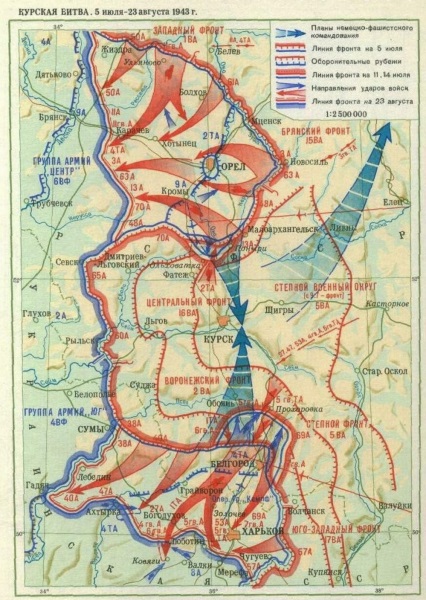
Map of the Battle of Kursk
Fact 3
The commanders of both sides were faced with difficult decisions in 1943 as to which strategy, attack or defence, was the best to pursue. And if the choice would be to attack, what aims were realistic to make? Both Russian and German commanders exerted considerable energy into answering these questions in the first few months of 1943.
Marshal Zhukov presented his argument in a report sent to the Soviet Headquarters in April concerning his recommendations for military operations in the coming months. Zhukov argued that the best decision for the Soviet forces under the current circumstances would be to strengthen the defensive lines and wait for the German attack. By eliminating as many German tanks as possible from strong defensive positions, a subsequent counter attack launched by divisions in reserve would be more effective than a pre-emptive attack. Zhukov’s ideas became the main basis for the summer campaign in 1943, especially after reconnaissance revealed that the German army was planning a huge attack on the Kursk Bulge.
As a result, the solution was the creation of an in depth (8 line) defence across the most likely areas of a possible German offensive, specifically on the northern and southern shoulders of the Kursk salient.
Facing a similar strategic situation, the German high command, not without considerable reservations from many of its generals, decided to attack, in order to keep the initiative. Nevertheless, the purpose of the planned offensive was not to capture territory, but, as with Soviet intentions, to wear down the opposing army. Thus as the German army was preparing to use an attack as part of a campaign of strategic defence, the Soviet army was planning to use defence as the springboard for a future attack.
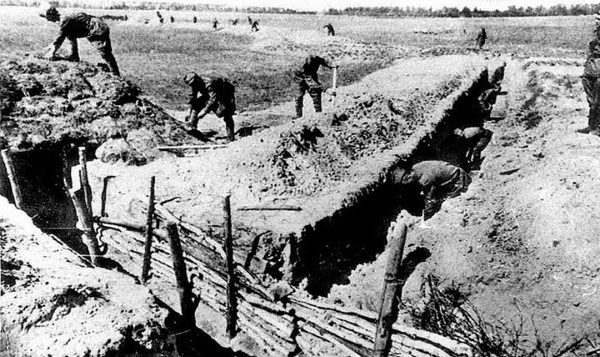
Construction of defensive lines
Fact 4
Although the Soviet command for the most part correctly calculated the likely directions and strengths of the coming German attack, mistakes in a battle plan of such bewildering scale as Kursk were inevitable.
Thus the Soviet Headquarters expected the fiercest attack to come from the Oryol Region near the centre of the front. In actual fact the strongest blow was delivered from Army Group South, who struck at the Voronezh Front.
Also the Soviet military planners did not correctly gauge the direction from which this German blow on the southern shoulder of the salient would come.
Fact 5
Operation “Citadel”, as the plan of German attack was codenamed, was meant to encircle and wipe out the Soviet armies positioned within the Kursk Bulge. The pincer movements were to be delivered from the North from the region of Oryol and from the South from the region of Belgorod. The pincers were then to meet around Kursk. Hoth’s Panzer Corps was to play an important role with a turn towards Prokhorovka, specially chosen by the German armed command as the wide open spaces of the steppe in this area would provide excellent ground for the rapid and large-scale tank manoeuvres favoured by German military strategy. It was here at Kursk that the Germans, hoping to employ their new tank designs to maximum effectiveness, hoped to considerable reduce the armoured strength of the Soviet army.
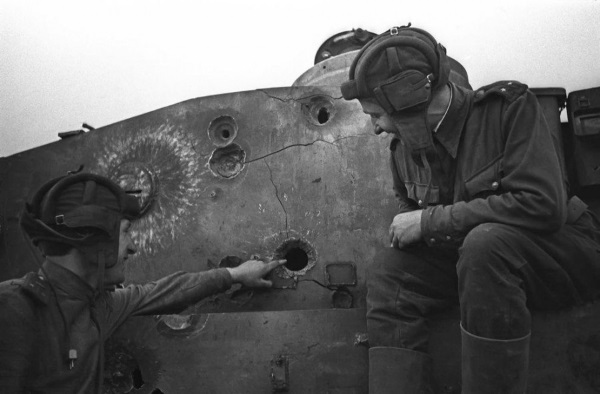
Soviet tank crew examine a destroyed "Tiger"
Fact 6
The Battle of Prokhorovka is often named the largest tank battle in history, but actually this is not the case. The battle which took place over a number of days from 23-30 June 1941 over the very first week of Operation Barbarossa between the towns of Brody, Lutsk and Dubno in the territory of what is now Western Ukraine was actually larger in terms of the number of tanks. The battle involved more than 3200 tanks, whereas at the battle of Prokhorovka the armed forces of each side numbered about 1500 tanks.
Fact 7
At the Battle of Kursk, and particularly at the engagement at Prokhorovka, the Germans were counting on the success of their new armour designs, the “Tiger” and “Panther” tanks, and the self-propelled “Ferdinand” gun. Yet perhaps the most unusual new design was the ironically named “Goliath” mini tank. The small unmanned bomb moving on caterpillar tracks was connected to the controller by a 650 metre cable. The weapon was intended for the destruction of tanks, infantry and buildings. However, the devices were expensive, slow-moving and vulnerable, and therefore proved of little help to the Germans in the fast-flowing environment of the Battle of Kursk.
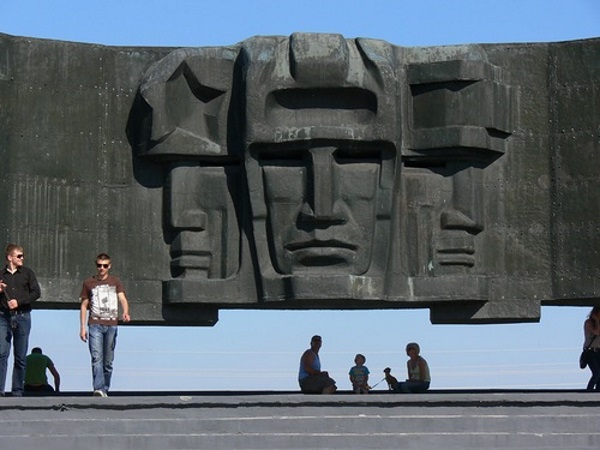
The Memorial to the Heroes of Kursk
New publications

 Mikhail Kalatozov, a director who transformed the world of cinematography in many ways, was born 120 years ago. He was a Soviet film official and a propagandist. Above all, he was capable of producing movies that struck viewers with their power and poetic language.
Mikhail Kalatozov, a director who transformed the world of cinematography in many ways, was born 120 years ago. He was a Soviet film official and a propagandist. Above all, he was capable of producing movies that struck viewers with their power and poetic language.  Ukrainian authorities have launched a persecution campaign against the canonical Ukrainian Orthodox Church (UOC), the biggest one in the country's modern history. Over the past year, state sanctions were imposed on clergy representatives, searches were conducted in churches, clergymen were arrested, criminal cases were initiated, the activity of the UOC was banned in various regions of the country, and monasteries and churches were seized.
Ukrainian authorities have launched a persecution campaign against the canonical Ukrainian Orthodox Church (UOC), the biggest one in the country's modern history. Over the past year, state sanctions were imposed on clergy representatives, searches were conducted in churches, clergymen were arrested, criminal cases were initiated, the activity of the UOC was banned in various regions of the country, and monasteries and churches were seized.  When Nektary Kotlyaroff, a fourth-generation Russian Australian and founder of the Russian Orthodox Choir in Sydney, first visited Russia, the first person he spoke to was a cab driver at the airport. Having heard that Nektariy's ancestors left Russia more than 100 years ago, the driver was astonished, "How come you haven't forgotten the Russian language?" Nektary Kotlyaroff repeated his answer in an interview with the Russkiy Mir. His affinity to the Orthodox Church (many of his ancestors and relatives were priests) and the traditions of a large Russian family brought from Russia helped him to preserve the Russian language.
When Nektary Kotlyaroff, a fourth-generation Russian Australian and founder of the Russian Orthodox Choir in Sydney, first visited Russia, the first person he spoke to was a cab driver at the airport. Having heard that Nektariy's ancestors left Russia more than 100 years ago, the driver was astonished, "How come you haven't forgotten the Russian language?" Nektary Kotlyaroff repeated his answer in an interview with the Russkiy Mir. His affinity to the Orthodox Church (many of his ancestors and relatives were priests) and the traditions of a large Russian family brought from Russia helped him to preserve the Russian language.

 The leaders of the Friends of the Great Russia cultural association (Amici Della Grande Russia) in Italy believe that the Western policy of abolishing Russian culture in Europe has finally failed. Furthermore, it was doomed to failure from the beginning.
The leaders of the Friends of the Great Russia cultural association (Amici Della Grande Russia) in Italy believe that the Western policy of abolishing Russian culture in Europe has finally failed. Furthermore, it was doomed to failure from the beginning.  Name of Vladimir Nemirovich-Danchenko is inscribed in the history of Russian theater along with Konstantin Stanislavski, the other founding father of the Moscow Art Theater. Nevertheless, Mr. Nemirovich-Danchenko was a renowned writer, playwright, and theater teacher even before their famous meeting in the Slavic Bazaar restaurant. Furthermore, it was Mr. Nemirovich-Danchenko who came up with the idea of establishing a new "people's" theater believing that the theater could become a "department of public education."
Name of Vladimir Nemirovich-Danchenko is inscribed in the history of Russian theater along with Konstantin Stanislavski, the other founding father of the Moscow Art Theater. Nevertheless, Mr. Nemirovich-Danchenko was a renowned writer, playwright, and theater teacher even before their famous meeting in the Slavic Bazaar restaurant. Furthermore, it was Mr. Nemirovich-Danchenko who came up with the idea of establishing a new "people's" theater believing that the theater could become a "department of public education."  "Russia is a thing of which the intellect cannot conceive..." by Fyodor Tyutchev are famous among Russians at least. December marks the 220th anniversary of the poet's birth. Yet, he never considered poetry to be his life's mission and was preoccupied with matters of a global scale. Mr.Tyutchev fought his war focusing on relations between Russia and the West, the origins of mutual misunderstanding, and the origins of Russophobia. When you read his works today, it feels as though he saw things coming in a crystal ball...
"Russia is a thing of which the intellect cannot conceive..." by Fyodor Tyutchev are famous among Russians at least. December marks the 220th anniversary of the poet's birth. Yet, he never considered poetry to be his life's mission and was preoccupied with matters of a global scale. Mr.Tyutchev fought his war focusing on relations between Russia and the West, the origins of mutual misunderstanding, and the origins of Russophobia. When you read his works today, it feels as though he saw things coming in a crystal ball...